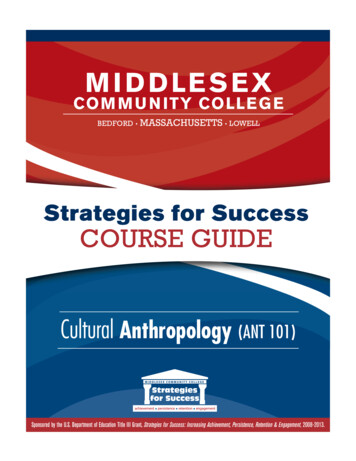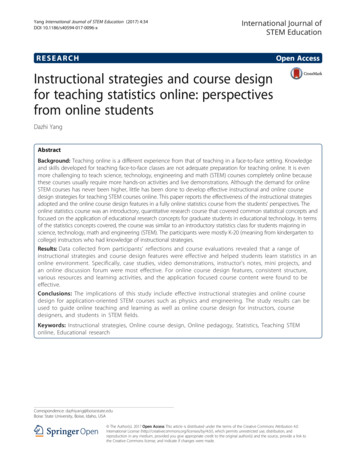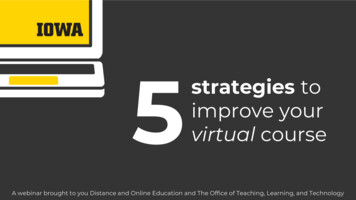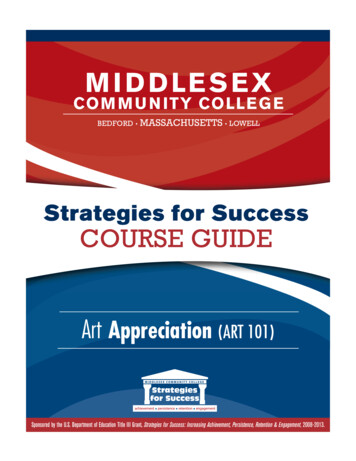
Transcription
M I D D LE S E XCOM M U N ITY COLLE G EBEDFORD MASSACHUSETTS LOWELLStrategies for SuccessCOURSE GUIDECultural Anthropology (ANT 101)Sponsored by the U.S. Department of Education Title III Grant, Strategies for Success: Increasing Achievement, Persistence, Retention & Engagement, 2008-2013.
Title III Strengthening Institutions ProjectStrategies for Success: Increasing Achievement,Persistence, Retention and EngagementThe Strategies for Success Title III initiative is a major, five‐year project (2009‐2013) funded bya two million dollar grant from the U.S. Department of Education. This initiative is intended totransform Middlesex Community College by improving the academic achievement, persistence,retention, and engagement of its students.The project focuses on reformed curricula and comprehensive advising. Reformed Curriculuminvolves the design of developmental and college Gateway courses and learning communitiesembedded with Core Student Success Skills related to critical thinking, communication,collaboration, organization, and self‐assessment. Overall, 45 courses will be impacted over thefive years of the project. Comprehensive Advising involves the design of integrated advisingservices to include identification of academic and career goals, creation of realistic educationalplans, and continuous tracking and intervention with an emphasis on the Core Student SuccessSkills. Comprehensive Advising Services will be specifically tailored to each program of study.Cross‐division curriculum and advising design teams composed of faculty and staff aredesigning, piloting, and assessing the curriculum and advising initiatives.The Title III grant provides resources to support faculty professional development related todesigning and piloting new curriculum and advising students. The grant also supports thepurchase of advising software programs and the hiring of a Pedagogical Instructional Designer,Learning Engagement Specialist, Advising Coordinator, and two academic advisors. Theresources provided by the grant offer an exciting opportunity for the college community towork together to develop the strong programs and services that will increase student success.
1ContentsIntroduction: Resource Guide for Infusing College Student Success Skills . 3Unit 1: Introduction to Cultural Anthropology . 6Lesson Plan: World’s Countries . 6Unit 2: Culture. 7Lesson Plan: Culture. 7Lesson Plan: Is It Ethnocentrism? . 7Lesson Plan: Cultural Relativism . 8Lesson Plan: Proverbs . 9Handout: Paired Proverbs. 11Lesson Plan: Values. 13Lesson Plan: Cultural Differences . 13Unit 3: Doing Anthropology (Research Methods) . 15Lesson Plan: Cultural Scene Ethnography (Semester Long Project ). 15Handout: Cultural Scene Ethnography Project. 16Handout: Assignment Option II‐Term Paper Assignment . 20Lesson Plan: Observation. 22Lesson Plan: Gang Leader for a Day. 23Unit 4: Language . 25Lesson Plan: Language . 25Lesson Plan: Do Chimps Have Language?. 25Unit 5: Subsistence Strategies . 27Lesson Plan: The Better Life?. 27Lesson Plan: Work and Leisure . 27Unit 6: Economy and Exchange Systems . 29Lesson Plan: Exchange . 29Unit 7: Family and Marriage . 30Lesson Plan: Marriage. 30Unit 8: Gender. 31Lesson Plan: Cultural Construction of Gender. 31Lesson Plan: Gender Roles, Patriarchy, and ‘Sworn Virgins’ . 32Unit 9: Kinship and Descent. 33Lesson Plan: Polyandry‐‐ when brothers take a wife. 33Lesson Plan: Revitalization Movements . 34
2Unit 10: Religion. 36Lesson Plan: Religion. 36Unit 11: Political and Legal Systems . 37Lesson Plan: The Kindness of Strangers‐The U.S. and Iraq. 37Unit 12: Globalization (and Culture Change) . 39Lesson Plan: Country Poster . 39Handout: Country Poster . 40Lesson Plan: Kiva Micro Loan. 40Lesson Plan: Immigrant Interview . 41Handout: Instructions for Immigrant Interview . 43Lesson Plan: Barbie Dolls, Strawberries, Nike Shoes . 44Handout: Means of Production . 46Lesson Plan: Colonialism. 47Lesson Plan: Indigenous Peoples . 48Unit 13: World Problems . 49Lesson Plan: Whom to Leave Behind. 49Lesson Plan: Free Rice. 50Unit 14: Medical Anthropology. 52Lesson Plan: Coining and Cupping . 52Appendix: Sample Syllabi. 53Syllabus Sample 1: INTRODUCTION TO CULTURAL ANTHROPOLOGY (InstructorBumbulucz) . 53Sample Syllabus II: INTRODUCTION TO CULTURAL ANTHROPOLOGY (Instructor Ercem). 58Sample Syllabus II: INTRODUCTION TO CULTURAL ANTHROPOLOGY (InstructorMustapha). 70
3Introduction: Resource Guide for Infusing College Student Success SkillsANT 101 Cultural Anthropology focuses on the study of society and social behavior.Major topics covered in this course include culture, socialization, research methods,deviance, social interaction and social groups, race and ethnicity, global inequalities,social class, family and social change. The major objectives of this course are to impartthe sociological imagination to students and help them gain an understanding of thespecial insights into social behavior and social forces that this perspective offers.This course satisfies a Behavioral Science Elective and also the Multicultural/GlobalAwareness Intensive Value.As a part of the Title III grant, Strategies for Success: Increasing Achievement,Persistence, Retention and Engagement, this course has been redesigned to incorporatethe following College Student Success Skills (CSSS): Critical Thinking, Collaboration,Communication, Organization, and Self‐Assessment. The course materials and activitiesfocus on helping students to develop these key skills which have been linked to successin college classrooms. The purpose of the grant is to help students apply these skills asthey learn the course content. Students will have an opportunity to think more explicitlyabout these skills, apply them while learning about and engaging with theories andconcepts of society, and then demonstrate how they have improved theircommunication, Critical Thinking, collaboration, organization and self‐reflection skills bythe end of the semester.What are Key Student Success Skills?Critical Thinking includes the ability to use and analyze information gathered frommultiple sources and form conclusions based on evidence rather than assumption.Critical Thinking involves a variety of means for integrating knowledge, using reasoningand solving problems. At its “Developing” Level (Application) it requires that studentsidentify and use relevant information and reach conclusions consistent with evidencepresented. At more “Proficient” and “Advanced” Levels it requires that studentscompare and contrast differing views, analyze and evaluate information logically, andmake inferences based on testable hypotheses.Communication skills can include the ability to write, speak, use numbers, and/or usetechnology effectively. Communication entails the ability of students to explain ideasrelated to what they are learning in clear oral or written forms. Such information may bepresented individually or in groups. Skills may include the ability to break content downinto smaller pieces, organizing and summarizing information, and demonstratinginformational, technological, and quantitative literacy.Collaboration includes participating as a member of a community, either as part of a
4group of students in the class, and/or a group of people outside of the classroom.Collaboration rests on the skills necessary for students to work together in groupactivities and projects. This includes direct skills such as dividing tasks into parts,collecting and sharing information, and making group decisions. It also includes skillsrelated to the processes for learning in community with others such as learning toappreciate differences, negotiating, compromising, and reaching consensus.Organization skills related to time management, note‐taking, test‐taking, and studyingare important for success in college. Organization involves a variety of related abilities.These include the ability to systematically relate areas of content to each other, theability to take an overarching piece of information and to present concepts in a logicalmanner, and the ability to come up with an outline to show how concepts relate to oneanother. It may also include the ability to read and follow the syllabus, timemanagement, and the use of effective study skills.Self‐assessment skills include setting academic and career goals, developing andfollowing a plan to achieve those goals, and utilizing college resources to help studentsachieve their goals. It involves the ability to assess oneself to gain insight into how onelearns, plans, makes decisions, and studies. It also involves the ability to examine howrelevant theories apply to real life.How do Skills Connect to Course Content?We designed a number of activities to help students link the course content to differentstudent success skills. We have arranged these activities by course topic for easyreference. The course topics and activities are in the order in which they are frequentlyfound in an Introduction to Sociology textbook. To this extent, the activities can be seenas building from the introductory level of sociological knowledge to a somewhat moreadvanced level of exposure to sociological thinking as students move through thecourse. Each activity specifies which student success skills apply; many of the activitiesemphasize more than one skill. Please use these activities, amend them to suit yourstudents’ particular needs, and let us know what works in your classes. We would alsolike to hear from you about activities you have used that you find effective.This resource guide was designed by two faculty members currently teaching the courseto share with other faculty who teach the course. We hope that these activities, whichcan and should be modified as appropriate, spark ideas for other activities. We haveorganized the guide as follows: A table of contents for the curriculum guide.Course lesson plansAppendix (consisting of the following)Sample course syllabi pageActivity Handouts
5We hope you find this guide useful; we enjoyed collaborating to develop it, and ourattached syllabi reflect the integration of several of each others’ ideas into our owncourse.Team Members:Binnur Ercem (ercemb@middlesex.mass.edu),Susan Bumbulucz (Bumbuluczs@middlesex.mass.edu)Mentor Mustafa (MUSTAFAM@middlesex.mass.edu )
6Unit 1: Introduction to Cultural AnthropologyLesson Plan: World’s CountriesLearning Objective: After successfully completing this activity, students will be able to: Enhance their knowledge of location of different countries in respect to oneanother.Core Student Success Skills Addressed: Self‐AssessmentCourse Topic Link: Introduction to Cultural AnthropologyInstructions:1. Put a blank world map in the class, with only the outline of nations drawn in.2. Ask students to locate nations of your choice.3. If there are students from other cultures, see if they know world geographybetter than North Americans do.Assessment/Reflection: Students will be given points every time they locate a countrycorrectly and will compare their own results with their classmates’ results.
7Unit 2: CultureLesson Plan: CultureLearning Objectives: After successfully completing this activity, students will be able to: Define the idea of culture. Describe the ways in which non‐human primates exhibit culture. Compare non‐human primate culture to human culture.Core Student Success Skills Addressed: Critical Thinking, Communication, andCollaborationCourse Topic Link: CultureInstructions:1. Explore the debate on non‐human primates and culture through the following web‐sites and video.“Orangutans Show Signs of Culture, Study Says” (National Geographic 02/12/1220 021226 orangutan.htmlKoko (The Gorilla Foundation .html“Koko: A Talking Gorilla” (video) found athttp://www.youtube.com/watch?v Pmuu8UEi2ko2. Ask students to come to class prepared to discuss the concept of culture, based bothon the textbook definition and these articles and video.Assessment/Reflection: Small class groups (of 4‐6 students) reflect on the activity.Each group assigns a leader to take notes of the discussion and then share their ideaswith the class as a whole.Lesson Plan: Is It Ethnocentrism?Learning Objectives: After successfully completing this activity, students will be able to: Identify examples of ethnocentrismCore Student Success Skills Addressed: Critical Thinking, CommunicationCourse Topic Link: CultureInstructions:1. The students read the text book material on ethnocentrism in the chapter on culture.
82. Using the news links provided in Blackboard or in the Lexus Nexus data base on theMCC library web site, students find an example of ethnocentrism in a news article onlinewithin the past six months.3. Students write a summary of their article with the link to the article and provide aclear explanation of how ethnocentrism is demonstrated in the article. They mustdemonstrate that they understand the meaning of ethnocentrism in their explanation.4. Students exchange papers in class with other students. Each student then critiquesthe work written by the other student by answering the question: Does her/hisexample fit the meaning of ethnocentrism? Why or why not?5. This is followed by a whole class discussion of examples, differentiating betweenethnocentrism and simple “dislike” or “disapproval” of someone or group.Assessment/Reflection: Responses are graded based on whether and to what extentstudents identify accurate or inaccurate examples of ethnocentrism and adequatelyexplain the rationale behind their assessment.Lesson Plan: Cultural RelativismLearning Objectives: After successfully completing this activity, students will be able to: Recognize examples of cultural relativismCore Student Success Skills Addressed: Critical Thinking, Communication, Self‐AssessmentCourse Topic Links: CultureInstructions:1.Bring a copy of the article entitled “Body Ritual Among the Nacirema”, and havea student read it out loud to class (see Appendix B).2.Nacirema is American backwards. It is written by an anthropologist as if he werean outsider looking at American culture from an ethnocentric point of view, the sameway that many Americans might look at other cultures.3.Ask students who have heard about or read the article before to keep quiet.
94.Once the reading is finished, ask the students to comment. Tell students to feelfree to comment on what parts of this culture they think are strange, unusual, anddisturbing.5.Reveal to students that Nacirema is American backwards and the article talksabout the American culture. Go back to passages in the article and ask students toidentify what was being described.6.Ask students to find an American cultural practice such as Halloween, SuperBowl etc. and write about it from an outsider’s perspective.Assessment/Reflection: This is an exercise on self‐identification of ethnocentrism andgives students some practice in applying cultural relativism. Students will be assessed onhow well they can describe an American activity from an outsiders’ point of view and onwhether they can articulate how ethnocentrism and cultural relativism apply to theauthor’s point of view as well as their own.Lesson Plan: ProverbsLearning Objectives: After successfully completing this activity, students will be able to: Identify cultural attitudes common to many cultures despite outwardly differentways of expressing these attitudesCore Student Success Skills Addressed: Critical Thinking, Self‐Assessment, CollaborationCourse Topic Link: CultureInstructions: This activity shows that although we have many differences when wecompare ourselves to other kinds of people, we also have many similarities. We mayhave different ways of talking and different behavior patterns, but many of our mostbasic needs and interests are similar. Participants will discover that, in many ways,people from different backgrounds and cultures hold similar values and beliefs.1. In advance, print the pairs of proverbs listed on the Proverb handout on indexcards so that each proverb appears on a separate card.2. Count the number of participants in the group and select enough cards to equalthe number of participants. If there are an uneven number of participants, theleader must participate in this activity.
103. Make sure that the cards are selected in matching pairs (one card with a proverbfrom the United States and one card with a similar proverb from anothercountry).4. Mix up the cards and pass out one card to each participant.5. When all cards have been distributed, ask participants to move around and findthe person who has a card with a similar proverb.6. Ask partners to stand together when they have found each other.7. For each set of partners, one person should have a proverb from the UnitedStates and the other person should have a proverb from another country.8. After most people have found their partner, ask those who have not found theirpartner to raise their hands.9. Ask those with raised hands to search among themselves for partners.10. When everyone has found their partner, ask each pair to read their proverbs outloud to the group.11. Ask the person with the proverb from the other country to read first, followed bythe person with the proverb from the United States.Assessment/Reflection:Ask what participants learned from this activity. Ask students how both culturaldifferences and similarities are reflected in the proverb pairs.Award students who can note the fact that everyone in the room is different and alsonote any differences that are apparent, such as the ages of group members, the parts ofthe state they are from, the types of community they live in, or the positions they hold.
11Handout: Paired ProverbsHe makes a wine cellar from one raisin. (Lebanon)He makes a mountain out of a molehill. (United States)Even a tiger will appear if you talk about him. (Korea)Speak of the devil and he will appear. (United States)God is a good worker, but he loves to be helped. (Spain)God helps those who help themselves. (United States)You can force a man to shut his eyes, but you can’t make him sleep. (Denmark)You can lead a horse to water, but you can’t make him drink. (United States)A little in your own pocket is better than much in another’s purse. (Spain)One bird in the hand is better than two in the bush. (United States)If you climb up a tree, you must climb down that same tree. (Ghana)What goes up, must come down. (United States)From the rain into the gutter. (Germany)From the frying pan into the fire. (United States)My house burned down, but it was a relief the bedbugs died. (Korea)Every cloud has a silver lining. (United States)He who is not in sight is not in the heart. (Tanzania)Out of sight, out of mind. (United States)Two captains sink the ship. (Japan)Too many cooks spoil the soup. (United States)By trying often, the monkey learns to jump from the tree. (Zaire)Practice makes perfect (or, if at first you don’t succeed, try, try again). (United States)A person that arrives early to the spring never gets dirty drinking water. (Zaire)The early bird gets the worm. (United States)I will not cry over a mishap and injure my eyes. (Tanzania)It is no use to cry over spilt milk. (United States)Trust in God but tie your camel. (Iran)God helps those who help themselves. (United States)
12A sparrow in the hand is better than a cock on the roof. (Russia)One bird in the hand is better than two in the bush. (United States)Where something is thin, that’s where it tears. (Russia)A chain is only as strong as its weakest link. (United States)Not everyone who has a cowl on is a monk. (Russia)Don’t judge a book by its cover. (United States)As you cooked the porridge, so must you eat it. (Russia)As you sow, so shall you reap. (United States)Every seed knows its time. (Russia)All in good time. (United States)
13Lesson Plan: ValuesLearning Objective: After successfully completing this activity, students will be able to: Understand values and how they may differ historically and cross culturally.Core Student Success Skills Addressed: Critical Thinking, communicationCourse Topic Link: CultureInstructions:1. Ask the students to make a list of their personal values.2. Ask them to make a separate list of what they think the values of otherAmericans are.3. Have them bring both lists to class and compare the lists to one another.4. How much discrepancy is there? Use this discrepancy, or lack of it, to discusswhat it means to say values are shared.5. If there are students from other cultures, compare their lists to the lists of otherstudents’ personal values and to the list of what students think are otherAmerican values.6. Discuss any discrepancy—what does this say about how other peoples perceiveAmericans? What does this say about the reality of their perceptions? Discussany similarities: are there any values that are universally human?Assessment/Reflection: Students will be assessed on the basis of their ability tounderstand individual values vs. cultural values and how values may differ from cultureto culture and how each example is as legitimate as the next one.Lesson Plan: Cultural DifferencesLearning Objective: After successfully completing this activity, students will be able to: Exercise the process of identifying cultural differences and similarities.
14Core Student Success Skills Addressed: Critical Thinking, communication, Self‐AssessmentCourse Topic Link: CultureInstructions:1. Ask students who have visited other countries what was the first thing theynoticed.2. They will likely bring up some differences.3. Use this opportunity emphasize that cultural differences are the “easiest” tonote and therefore the easiest to emphasize.4. The student will likely take for granted the similarities. Ask them if they couldidentify similar practices in their culture to those that struck them as verydifferent in other cultures.5. If there are students from other cultures in the class, you can also ask them theirfirst impressions of this country.6. If any of their reactions are negative, ask them why they made such a judgment.Assessment/Reflection: Students will be evaluated on the basis of their ability toexercise cultural relativism skills that they have learned in class.
15Unit 3: Doing Anthropology (Research Methods)Lesson Plan: Cultural Scene Ethnography (Semester Long Project )Learning Objectives: After successfully completing this activity, students will be ableto: Explain the concept of anthropological fieldwork.Have a solid grasp of what undertaking anthropological fieldwork entails.Core Student Success Skills Addressed: Critical Thinking, Communication,Collaboration, and OrganizationCourse Topic Link: Doing Anthropology (or Fieldwork)Instructions: The purpose of this assignment is to enable the student to participate ina cultural experience by doing some of the general ethnographic fieldwork in anAmerican cultural scene that is already familiar to the student. See followingassignment sheet for complete instructions.Assessment/Reflection: This ethnography will be assessed according to the followingcriteria: Writing: grammar, spelling, word choice, clarity, neatness, etc.Clear, detailed observations.Awareness and sensitivity to the role of being an outsider and doingparticipant observation as part of ethnographic research.Cultural analysis and/or problem solving; especially, the ability to see thingsfrom the “insider’s” point of view.Completed Research prospectus
16Handout: Cultural Scene Ethnography ProjectAssignment Option I:Purpose and ObjectiveThe purpose of this assignment is to enable the student to participate in a culturalexperience by doing some of the general ethnographic fieldwork in an Americancultural scene that is already familiar to the student. A cultural scene may be definedas “a geographic or symbolic place where two or more people repeatedly shareactivities that lead to shared understandings” (Kutsche 1998:85). Examples areabundant: schools, playgrounds, farms, nursing homes, restaurants and grocery storeswould all qualify as cultural scenes. Most of these could also be broken down intosmaller “scenes within the scene,” such as a particular classroom in a school, or theemergency room of a hospital.Your first procedure will be to select a scene for the site of your research. It is oftenhelpful to choose a site which is completely foreign to you but about which you arecurious; this will heighten your “outsider’s” perspective. However, for the purposes ofthis course it is also possible to choose a site which you are already involved with insome significant way, either through work or other activity. In this case, you must tryto imagine yourself as an “outsider” to see these already familiar surroundings from anobserver’s point of view.This project focuses on the primary anthropological research process known asethnography and the research technique known as participant‐observation. In writingyour ethnography, your primary goals will be to capture both the insider’s and theoutsider’s point of view, and to provide a cultural analysis. It must be rememberedthat an ethnography is not merely an objective description of people and theirbehavior from the observer's viewpoint; it is a systematic and careful attempt todiscover the knowled
Strategies for Success COURSE GUIDE . The Strategies for Success Title III initiative is a major, five‐year project (2009‐2013) funded by a two million dollar grant from the U.S










